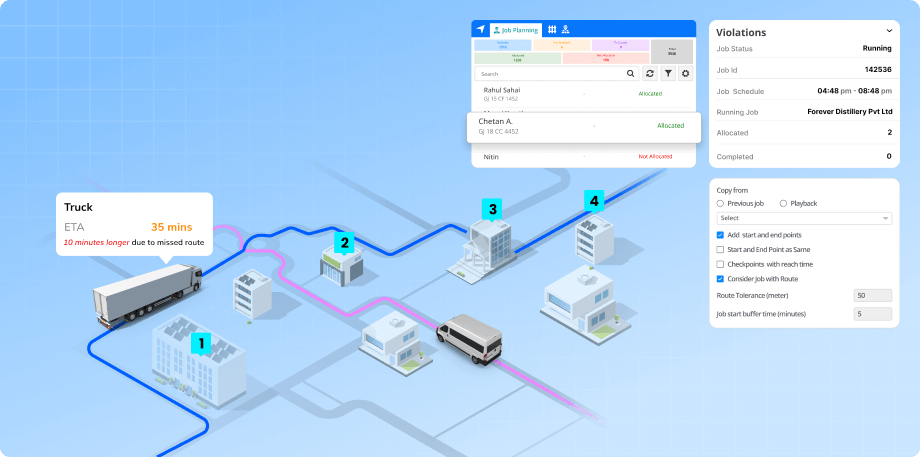In fleet operations and management, time is everything. Whether it’s last-mile delivery, field service, or bulk logistics, delays in job assignments or poorly optimized routes can lead to customer complaints and missed deadlines. Businesses handling multiple jobs per day often struggle with manual scheduling and chaotic dispatching. Advanced fleet software with job management and route optimization features can solve this. By digitizing job allocation and optimizing route sequences, businesses can cut travel time, avoid overlapping assignments, and deliver better on-ground service.
Improving fleet performance with job management and route planning
Introduction
Challenges
- Manual job scheduling causes confusion and slowdowns: When dispatchers have to assign jobs manually, it takes up a lot of their time. They may accidentally assign two jobs to the same vehicle or create a plan that’s not practical for the day’s workload. This leads to delays, overlaps, and often poor communication with drivers who are unclear about what’s expected of them.
- Planned routes don’t reflect ground-level realities: Traditional route planning doesn’t take live traffic, roadblocks, or driver schedules into account. So even if a plan looks good on paper, drivers may still face delays due to congestion or unexpected detours. As a result, jobs run late and customer satisfaction drops.
- No way to track how productively drivers are working: Fleet managers often don’t know how many jobs a driver completes in a day, how much time is spent on each job, or whether the job was even done on time. This lack of visibility makes it hard to recognize efficient workers or help those who are falling behind.
- Unclear job progress leads to missed follow-ups: Once the job is assigned, there’s little visibility into how things are going in the field. If a job is delayed or skipped, managers find out only at the end of the day—or worse, when the client calls to complain.
- Important job details get missed or recorded separately: Field teams often forget to take delivery photos, capture signatures, or record job remarks. And when these details are collected on paper or through WhatsApp, it’s hard to keep everything organized in one place.
Solution
- Easily create and manage job lists for each vehicle: Managers can manually add single or multiple jobs for any vehicle and assign them in bulk. Whether it’s pickup, delivery, maintenance, or on-site service, every job can be defined with location, time window, and task type. This makes it easy to create structured daily schedules.
- Optimize the order of jobs with a single click: The system doesn’t select vehicles or drivers, but it can optimize the sequence of jobs assigned to a specific vehicle. It reorders the job list to ensure the least amount of travel time. This helps in reducing the distance covered and making better use of the driver’s time on the road.
- Track job status live from the timeline view: Managers can track which jobs are pending, ongoing, or completed in real time. This gives a live overview of execution progress across all vehicles and ensures no job is missed or delayed without visibility.
- Update job progress directly from the driver app: Drivers can use the mobile app to view their assigned job list and update their status as they complete each task. They can also pause a job, add remarks, or change the sequence manually if needed, keeping communication clear and real-time.
- Maintain digital records with every job: Drivers can upload images, collect signatures, and add notes for each job through the app. These records are stored with the job details, providing clear proof of completion and minimizing back-and-forth for confirmation.
Results
- Reduced travel time and operational delays: By optimizing the job sequence for each vehicle, fleets significantly cut down on unnecessary travel and detours. This leads to faster job completion and smoother daily operations.
- Improved task visibility and on-time completion: Real-time tracking of job progress ensures that managers can intervene early in case of delays. Most fleets experience a noticeable increase in on-time job completion rates after implementing this feature.
- Better documentation and accountability: With photos, remarks, and digital signatures collected per job, businesses maintain clear records for every task completed. This leads to fewer disputes, better compliance, and faster reporting.




